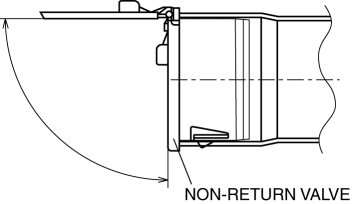Mazda 3 Service Manual: Non Return Valve Inspection [Mzr 2.0, Mzr 2.5]
WARNING:
-
Fuel is very flammable liquid. If fuel spills or leaks from the pressurized fuel system, it will cause serious injury or death and facility breakage. Fuel can also irritate skin and eyes. To prevent this, always complete the “Fuel Line Safety Procedure”, while referring to the “BEFORE SERVICE PRECAUTION”.
-
A person charged with static electricity could cause a fire or explosion, resulting in death or serious injury. Before draining fuel, make sure to discharge static electricity by touching the vehicle body.
Except for Mexico
1. Complete the “BEFORE SERVICE PRECAUTION”..
2. Disconnect the negative battery cable..
3. Remove the fuel pump unit..
4. Siphon the fuel from the fuel tank.
NOTE:
-
The non-return valve is integrated in the fuel tank.
-
The non-return valve is normally closed by the spring force.
5. Verify that the non-return valve is closed.
-
If the non-return valve is stuck open and does not open even when pulled up by a finger, replace the fuel tank..
Mexico
1. Complete the “BEFORE SERVICE PRECAUTION”..
2. Remove the non-return valve..
3. Verify that the non-return valve is closed.

-
If malfunction, replace the non-return valve..
4. Verify that the non-return valve is not stuck open and does not open even when pulled up by a finger.
-
If malfunction, replace the non-return valve..
 Engine Tune Up [Skyactiv G 2.0]
Engine Tune Up [Skyactiv G 2.0]
Engine Tune-up Preparation
NOTE:
If the accelerator pedal is depressed continuously for a specified time,
the engine speed may decrease to the idle speed. This is due to the fuel cut
co ...
 Non Return Valve Inspection [Mzr 2.3 Disi Turbo]
Non Return Valve Inspection [Mzr 2.3 Disi Turbo]
WARNING:
Fuel is very flammable liquid. If fuel spills or leaks from the pressurized
fuel system, it will cause serious injury or death and facility breakage. Fuel
can also irritate skin ...
Other materials:
Air Intake Actuator Removal/Installation [Manual Air Conditioner]
1. Set the air intake mode to FRESH.
2. Disconnect the negative battery cable..
3. Remove the following parts:
a. Front scuff plate (Passenger-side).
b. Front side trim (Passenger-side).
c. Dashboard under cover.
d. Glove compartment.
e. Lower panel (Passenger-side).
f. Shower duct ( ...
Forced Ignition On [With Advanced Keyless Entry And Push Button Start System]
NOTE:
In order to perform a forced ignition ON, the M-MDS (IDS) is necessary. If
the servicing is being done outside of an Authorized Mazda dealership, contact
an Authorized Mazda dealership for instructions.
The forced ignition ON procedure forces a power supply to each part w ...
Throttle Position (TP) Sensor Inspection [Mzr 2.0, Mzr 2.5]
Voltage Inspection
CAUTION:
The inspection cannot be performed with this method correctly if there is
a malfunction of the APP sensor or throttle valve actuator. Verify that no DTCs
related to the APP sensor or throttle valve actuator are stored before the inspection.
NOTE:
...
